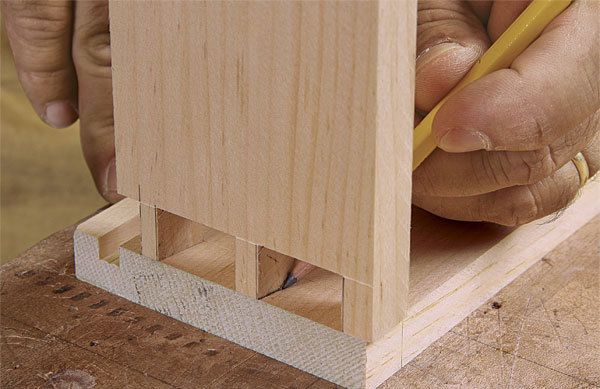Layout: When Pencil Beats Knife
For accurate dovetails and hinge mortises, you’re better off with the humble pencil.

Synopsis: Although many woodworkers use marking knives and gauges to cut layout lines, students at North Bennet Street School learn to use a pencil when laying out dovetails and hinge mortises. Instructor Steve Brown argues that a sharp pencil makes a more accurate line and, because it doesn’t damage the wood or cut into any part of the joint, results in a tighter, better-fitting joint. Here he shows how to transfer dovetails accurately and mark and cut a hinge mortise will always leave you with a perfect fit.
From Fine Woodworking #224
Good joinery begins with accurate layout, and for many woodworkers that means using marking knives and gauges to cut layout lines. Pencils typically don’t enter into the discussion, because a drawn line is supposedly less accurate. But a pencil line can be just as accurate as a scribed one and there are times when a pencil is a better choice for layout than a marking knife.
At North Bennet Street School, where I teach cabinet and furniture making, students learn to use a pencil instead of a knife when laying out dovetails and hinge mortises. In those cases, the knife cuts into the wood you want to keep, resulting in a loose or gappy fit. A sharp pencil marks a line that’s just as accurate, but doesn’t damage the wood. It also is easier to see. I’ll show you how to do it.
Pencils don’t damage wood: No matter how you cut dovetails (I do them pins first), you’re going to trace one half of the joint onto the board for the other half. I stand the pin board on the face grain of the tail board. All of the wood between the pins will become the tails, so it is wood that I want to keep. If you trace the pins with a knife, pressing it firmly against the pins, you cut into wood that will be part of the tails. If you later remove that scribe line when paring the tails, the joint may be too loose. If you leave it, then there will be a small gap visible, created by the beveled edge of the knife. (The same is true for a hinge mortise. As you scribe around the leaf, the knife cuts into a part of the stile that needs to be kept.)
A sharp pencil avoids those problems. It draws a line along the pin and the entire line is on wood that needs to be kept. So, when it comes time to cut and pare the tails, you work up to the line, but not into it (this also is true for a hinge mortise).
Transfer dovetails accurately: You don’t need a fancy pencil. A good, old-fashioned No. 2 works great. But the point does need to be as sharp as possible. After sharpening it in a pencil sharpener, use P220-grit sandpaper to sharpen it to a finer point, twirling it in your fingers as you do so.
As I mentioned, I cut pins first. However, this technique works if you cut tails first, too, as long the space between them is large enough for a pencil to fit.
For the full article, download the PDF below:
Fine Woodworking Recommended Products

Suizan Japanese Pull Saw

Leigh D4R Pro

Freud Super Dado Saw Blade Set 8" x 5/8" Bore







Log in or create an account to post a comment.
Sign up Log in